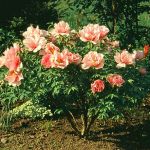| Common Name: |
Tree Peony |
| Other Names: |
Moutan Peony |
| Botanical Name: |
Paeonia suffruticosa syn. P. moutan |
| Genus: |
Paeonia |
| Family: |
Paeoniaceae |
| Native Location: |
China |
| Cultivation: |
Rich, well-drained soil in sun or partial shade, avoiding early morning sun, which may cause damage after frost. Remove dead wood from P. suffruticosa in early spring. Shoots and buds may be damaged by peony wilt (gray mold blight). Foliage may be damaged by leafspot and virus diseases. Buds and stem bases may be affected by Botyrtis. Susceptible to nematodes. |
| Propagation: |
By seed sown in autumn (species only); by division in autumn or early spring; by root cuttings in winter (P. lactiflora and P. officinalis); by layering or semi-ripe cuttings in spring, or grafting in winter (P. suffruticosa). Seed may take 2-3 years to germinate. |
| Harvest: |
Roots (P. lactiflora) are lifted from cultivated plants 4-5 years old, in late summer to mid-autumn, and boiled and dried for use in decoctions, pills, powders; wild plants are lifted in spring or (preferably) autumn and sun-dried. Roots (P. officinalis) are lifted from two-year-old plants and dried for decoctions. Root bark (P. suffruticosa is stripped from the roots in autumn and used raw or dried in decoctions. |
| Height: |
2.2m (7ft) |
| Width: |
2.2m (7ft) |
| Variations: |
Hana-daijin
Syn. Magnificent Flower
Has double violet flowers. |
Renkaku
Syn. Flight of Cranes
Has double white flowers with deep yellow stamens. |
Yae-zakura
Syn. Double Cherry
Has double pale pink flowers. |
|
| Hardiness: |
Z5-8 |
| Parts Used: |
Root bark (mu dan pi) |
| Properties: |
A pungent, bitter, analgesic herb that cools the blood, lowers blood pressure, and has anti-allergenic, anti-bacterial, and tranquilizing effects. |
| Tarot: |
II The High Priestess |
| Medicinal Uses: |
Internally for fevers, boils, menstrual disorders, nosebleed, ulcers, irritability, and gastrointestinal infections. Used raw for blood heat, stir-baked for stagnant circulation, and carbonized to control bleeding. |
| Warning: |
For Use by qualified practitioners only. |
| Bibliography: |
The Encyclopedia of Herbs by Deni Bown Copyright © 1995, 2001 Dorling Kindersley Limited. Pg. 299
The Herbal Tarot by Michael Tierra, Herbalist and Candis Cantin, Artist Copyright©1988 U.S. Games Systems Inc. Card II |
